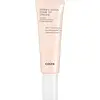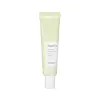What's inside
What's inside
 Key Ingredients
Key Ingredients

 Benefits
Benefits

 Concerns
Concerns

 Ingredients Side-by-side
Ingredients Side-by-side

Water
Skin ConditioningButylene Glycol
HumectantEthylhexyl Methoxycinnamate
UV AbsorberCyclopentasiloxane
EmollientCI 77891
Cosmetic ColorantGlycerin
HumectantEthylhexyl Salicylate
UV AbsorberCetyl Ethylhexanoate
EmollientNiacinamide
SmoothingOctyldodecanol
Emollient1,2-Hexanediol
Skin ConditioningDiethylamino Hydroxybenzoyl Hexyl Benzoate
UV FilterTriceteareth-4 Phosphate
EmulsifyingGlycol Stearate
EmollientCetearyl Alcohol
EmollientGlyceryl Stearate
EmollientPEG-100 Stearate
PEG-2 Stearate
EmulsifyingPotassium Cetyl Phosphate
EmulsifyingHydroxyethyl Acrylate/Sodium Acryloyldimethyl Taurate Copolymer
Emulsion StabilisingStearic Acid
CleansingSodium Acrylate/Sodium Acryloyldimethyl Taurate Copolymer
Emulsion StabilisingPalmitic Acid
EmollientPEG-10 Dimethicone
Skin ConditioningSnail Secretion Filtrate
Skin ConditioningSodium Polyacrylate
AbsorbentAluminum Hydroxide
EmollientSynthetic Fluorphlogopite
Isohexadecane
EmollientEthylhexyl Stearate
EmollientCaprylyl Glycol
EmollientPolysorbate 80
EmulsifyingTriethoxycaprylylsilane
Ethylhexylglycerin
Skin ConditioningSorbitan Oleate
EmulsifyingDisodium EDTA
Trideceth-6
EmulsifyingMyristic Acid
CleansingArachidic Acid
CleansingLauric Acid
CleansingOleic Acid
EmollientWater, Butylene Glycol, Ethylhexyl Methoxycinnamate, Cyclopentasiloxane, CI 77891, Glycerin, Ethylhexyl Salicylate, Cetyl Ethylhexanoate, Niacinamide, Octyldodecanol, 1,2-Hexanediol, Diethylamino Hydroxybenzoyl Hexyl Benzoate, Triceteareth-4 Phosphate, Glycol Stearate, Cetearyl Alcohol, Glyceryl Stearate, PEG-100 Stearate, PEG-2 Stearate, Potassium Cetyl Phosphate, Hydroxyethyl Acrylate/Sodium Acryloyldimethyl Taurate Copolymer, Stearic Acid, Sodium Acrylate/Sodium Acryloyldimethyl Taurate Copolymer, Palmitic Acid, PEG-10 Dimethicone, Snail Secretion Filtrate, Sodium Polyacrylate, Aluminum Hydroxide, Synthetic Fluorphlogopite, Isohexadecane, Ethylhexyl Stearate, Caprylyl Glycol, Polysorbate 80, Triethoxycaprylylsilane, Ethylhexylglycerin, Sorbitan Oleate, Disodium EDTA, Trideceth-6, Myristic Acid, Arachidic Acid, Lauric Acid, Oleic Acid
Water
Skin ConditioningCyclomethicone
EmollientZinc Oxide
Cosmetic ColorantButyloctyl Salicylate
Skin ConditioningPolyglyceryl-3 Polydimethylsiloxyethyl Dimethicone
Skin ConditioningIsododecane
EmollientCI 77891
Cosmetic ColorantButylene Glycol
HumectantCaprylyl Methicone
Skin ConditioningGlycerin
HumectantIsononyl Isononanoate
EmollientPolymethylsilsesquioxane
1,2-Hexanediol
Skin ConditioningTribehenin
EmollientDisteardimonium Hectorite
StabilisingSorbitan Sesquioleate
EmulsifyingMica
Cosmetic ColorantMagnesium Sulfate
Triethoxycaprylylsilane
Aluminum Hydroxide
EmollientStearic Acid
CleansingSalvia Sclarea Oil
MaskingPropylene Carbonate
SolventCentella Asiatica Extract
CleansingChamomilla Recutita Flower Extract
MaskingEthylhexylglycerin
Skin ConditioningGlyceryl Caprylate
EmollientTrihydroxystearin
Skin ConditioningDisodium EDTA
Dipropylene Glycol
HumectantMaltodextrin
AbsorbentMoringa Oleifera Seed Extract
Skin ConditioningSodium Palmitoyl Proline
Skin ConditioningSnail Secretion Filtrate
Skin ConditioningArtemisia Capillaris Extract
Water, Cyclomethicone, Zinc Oxide, Butyloctyl Salicylate, Polyglyceryl-3 Polydimethylsiloxyethyl Dimethicone, Isododecane, CI 77891, Butylene Glycol, Caprylyl Methicone, Glycerin, Isononyl Isononanoate, Polymethylsilsesquioxane, 1,2-Hexanediol, Tribehenin, Disteardimonium Hectorite, Sorbitan Sesquioleate, Mica, Magnesium Sulfate, Triethoxycaprylylsilane, Aluminum Hydroxide, Stearic Acid, Salvia Sclarea Oil, Propylene Carbonate, Centella Asiatica Extract, Chamomilla Recutita Flower Extract, Ethylhexylglycerin, Glyceryl Caprylate, Trihydroxystearin, Disodium EDTA, Dipropylene Glycol, Maltodextrin, Moringa Oleifera Seed Extract, Sodium Palmitoyl Proline, Snail Secretion Filtrate, Artemisia Capillaris Extract
Ingredients Explained
These ingredients are found in both products.
Ingredients higher up in an ingredient list are typically present in a larger amount.
1,2-Hexanediol is a synthetic liquid and another multi-functional powerhouse.
It is a:
- Humectant, drawing moisture into the skin
- Emollient, helping to soften skin
- Solvent, dispersing and stabilizing formulas
- Preservative booster, enhancing the antimicrobial activity of other preservatives
Aluminum Hydroxide is a form of aluminum. It can be naturally found in nature as the mineral gibbsite. In cosmetics, Aluminum Hydroxide is used as a colorant, pH adjuster, and absorbent.
As a colorant, Aluminum Hydroxide may add opacity, or reduce the transparency. Aluminum hydroxide is contains both basic and acidic properties.
According to manufacturers, this ingredient is an emollient and humectant. This means it helps hydrate the skin.
In medicine, this ingredient is used to help relieve heartburn and help heal ulcers.
There is currently no credible scientific evidence linking aluminum hydroxide in cosmetics to increased cancer risk.
Major health organizations allow the use of aluminum hydroxide in personal care products and have not flagged it as a carcinogenic risk at typical usage levels.
Learn more about Aluminum HydroxideButylene Glycol (or BG) is used within cosmetic products for a few different reasons:
Overall, Butylene Glycol is a safe and well-rounded ingredient that works well with other ingredients.
Though this ingredient works well with most skin types, some people with sensitive skin may experience a reaction such as allergic rashes, closed comedones, or itchiness.
Learn more about Butylene GlycolCi 77891 is a white pigment from Titanium dioxide. It is naturally found in minerals such as rutile and ilmenite.
It's main function is to add a white color to cosmetics. It can also be mixed with other colors to create different shades.
Ci 77891 is commonly found in sunscreens due to its ability to block UV rays.
Learn more about CI 77891Disodium EDTA plays a role in making products more stable by aiding other preservatives.
It is a chelating agent, meaning it neutralizes metal ions that may be found in a product.
Disodium EDTA is a salt of edetic acid and is found to be safe in cosmetic ingredients.
Learn more about Disodium EDTAEthylhexylglycerin (we can't pronounce this either) is commonly used as a preservative and skin softener. It is derived from glyceryl.
You might see Ethylhexylglycerin often paired with other preservatives such as phenoxyethanol. Ethylhexylglycerin has been found to increase the effectiveness of these other preservatives.
Glycerin is already naturally found in your skin. It helps moisturize and protect your skin.
A study from 2016 found glycerin to be more effective as a humectant than AHAs and hyaluronic acid.
As a humectant, it helps the skin stay hydrated by pulling moisture to your skin. The low molecular weight of glycerin allows it to pull moisture into the deeper layers of your skin.
Hydrated skin improves your skin barrier; Your skin barrier helps protect against irritants and bacteria.
Glycerin has also been found to have antimicrobial and antiviral properties. Due to these properties, glycerin is often used in wound and burn treatments.
In cosmetics, glycerin is usually derived from plants such as soybean or palm. However, it can also be sourced from animals, such as tallow or animal fat.
This ingredient is organic, colorless, odorless, and non-toxic.
Glycerin is the name for this ingredient in American English. British English uses Glycerol/Glycerine.
Learn more about GlycerinSnail Secretion Filtrate is the excretion from snails. It is an effective moisturizer and promotes collagen production.
A popular nickname for this ingredient is 'Snail Mucin'.
Snail mucin has numerous skin benefits:
On top of this, Snail Secretion Filtrate contains a variety of vitamins and minerals. These include copper peptides, Vitamin A, and vitamin E. Vitamins A and E are antioxidants. Antioxidants help fight free-radicals that damage skin cells.
Being cruelty-free means a brand does not experiment on animals.
If you're worried about the well-being of the snails, we recommend looking more into the company of the product. Many brands have developed humane methods to collect snail mucin.
There is much debate on this subject. On one hand, this ingredient comes from an animal. On the other hand, many will argue the ingredient is naturally secreted (like a natural by-product) and therefore vegan. If you have reservations, you can look into Galactomyces Ferment Filtrate or Centella Asiatica Extract as alternatives.
Learn more about Snail Secretion FiltrateStearic Acid is a fatty acid. It is an emollient, emulsifier, and texture enhancer.
As an emollient, stearic acid helps soften skin. It aids the skin's protective barrier by preventing water loss. It also provides a gentle cleansing effect without stripping away natural oils.
Stearic acid may also be used to enhance the texture of products. It can add volume and stabilize ingredients such as water and oil. This can help water and oil ingredients from separating.
Sources of stearic acid include animal or vegetable fats/oils such as coconut or shea. It can be naturally found in butter, cocoa butter, shea butter, vegetable fats, and animal tallow.
This ingredient may not be Malassezia folliculitis, or fungal-acne safe.
Learn more about Stearic AcidTriethoxycaprylylsilane is a silicone used to bind and stabilize ingredients.
As an emulsifier, it helps prevent ingredients from separating. This can help elongate the shelf life of products.
Triethoxycaprylylsilane is often used to coat mineral sunscreens ingredients to help give a better feel. It also helps reduce oxidative stress in sunscreens.
Learn more about TriethoxycaprylylsilaneWater. It's the most common cosmetic ingredient of all. You'll usually see it at the top of ingredient lists, meaning that it makes up the largest part of the product.
So why is it so popular? Water most often acts as a solvent - this means that it helps dissolve other ingredients into the formulation.
You'll also recognize water as that liquid we all need to stay alive. If you see this, drink a glass of water. Stay hydrated!
Learn more about Water